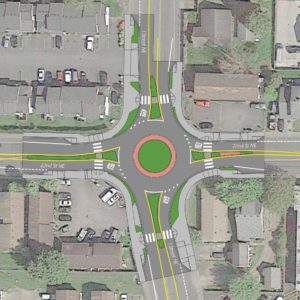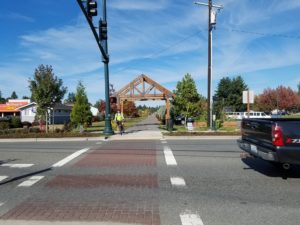Sustainability is a buzzword that has been in use for some time in the engineering industry.
According to Wikipedia: “Sustainable engineering is the process of designing or operating systems such that they use energy and resources sustainably, in other words, at a rate that does not compromise the natural environment, or the ability of future generations to meet their own needs.” This definition provides a broad framework for establishing what constitutes sustainable design as it applies to the transportation engineering discipline. It also allows the designer seeking to develop a sustainable design to narrow their focus to just two criteria, albeit two very complex criteria. While it may not be possible to draw a line between what is sustainable design and what is not, it is possible to maximize the sustainability of design elements. In a sense, sustainability is nothing new to engineering as often economics and ease of maintenance are the two primary drivers that lead to sustainable solutions. However, having a mindset that has an additional focus on what will “compromise the natural environment” or compromise “the ability of future generations to meet their own needs” may lead to alternative solutions that would not otherwise be considered.
Roundabouts: A Sustainable Solution

Virtually all of our transportation design projects at Reid Middleton contain some level of sustainable design elements. Roundabouts, for example, by their very nature provide a sustainable solution due to their ability to minimize traffic accident severity and maximize traffic mobility without the energy needs associated with traffic signals or, in many cases, the need to add lanes on roadway approaches or between intersections, while still accommodating future growth. A couple of our recent projects include the 22nd Street NE and I Street NE roundabout project for the City of Auburn that is currently under construction and the Park Street and E North Bend Way roundabout project for the City of North Bend scheduled for construction later in 2018. Both of these projects significantly increased intersection capacity while matching into the existing lane configuration on intersecting approach roadways.
Sustainable Design Elements

Other sustainable design elements that are common to many of our projects include LED lighting, pavement recycling, and multi-modal design, which helps promote alternative sustainable modes of travel. Our Arlington Valley Road project for the City of Arlington that is just starting construction contained provisions for all of these elements. The multi-modal aspect of this project includes a separated shared-use path next to the roadway, which expands the City of Arlington’s trail network by connecting to the Centennial Trail.
An additional sustainable design element that was uniquely applied to this project is a Low Impact Development (LID) technique using bioretention (a bioretention cell is shown in the featured image of this blog) and infiltration of stormwater runoff from all impervious surfaces where treatment and flow control were required. While many projects include some bioretention and infiltration facilities to augment non-LID treatment and detention of stormwater runoff, rarely do projects use LID treatment and infiltration for all of the stormwater runoff on-site without diverting at least some of the flow elsewhere for treatment or detention in an adjacent non-LID system.
Integrating sustainable design elements into our transportation projects is a practice that we take seriously as stewards of infrastructure design.

